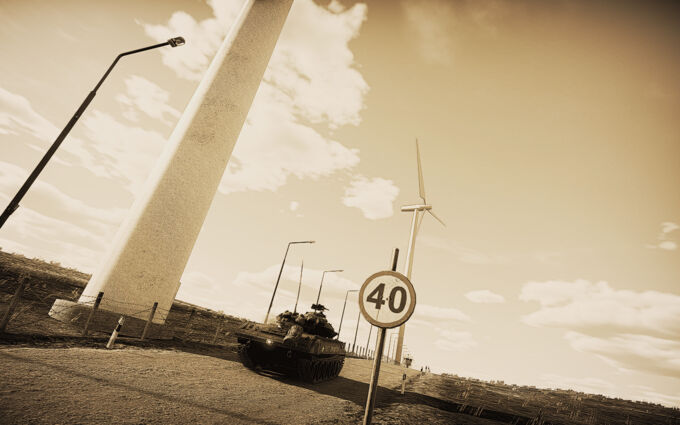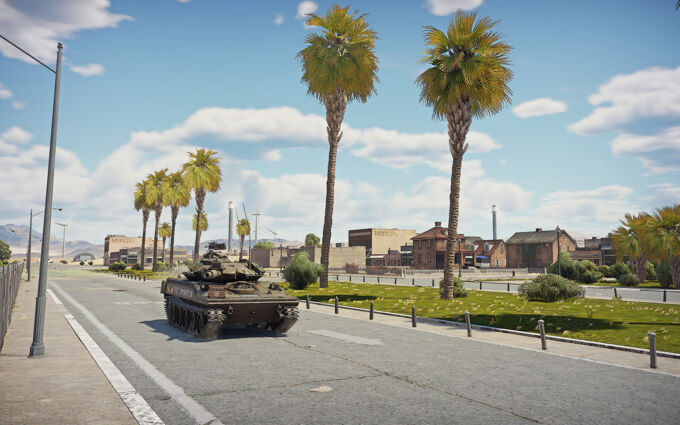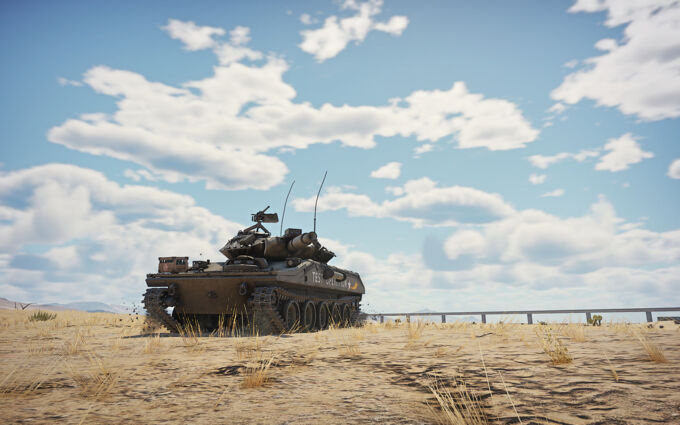The M551 Sheridan, described with a single expression, would in my opinion be 'the black sheep of the family'. Very much unlike its peers, the Sheridan stands out simply for the fact that it comes equipped with a powerful, large caliber gun. The 152mm Gun/Launcher allows the Sheridan to engage targets at all ranges, be they long or short, and it’s not particularly held back by its mobility either — it’s a staggering 8 tons lighter than the 23-ton M41 Bulldog! However, the Sheridan’s shortcomings are just as polarizing as its armament, with its armor being woefully inadequate at protecting the vehicle and the lack of a laser rangefinder leaving its sustained long-range performance fairly mediocre. While not the most intuitive vehicle to use, once familiarized the Sheridan can offer much for your lineup — let’s find out just how it performs, and if the black sheep of the family can find itself a home in your hangar!
A Very Brief History
The M551 Sheridan was born out of the ashes of the T71 and T92 programs, to replace the US Army’s M41 Bulldog light tank as well as the M56 self-propelled gun. The PT-76 had just killed the T92 program, the vehicle being ill-suited for amphibious operations the PT-76 was very much capable of, and the Army was looking for a vehicle that could both replace the M41/M56 and also have amphibious capabilities to match. The result was the Sheridan, a 15 ton light tank equipped with the then-new 152mm Gun/Launcher to save weight that was also amphibious.
Equipped with a 152mm gun that can fire both ATGMs and conventional HEAT/HE shells on a turret with a dual-plane stabilizer, the Sheridan managed to accomodate higher firepower in a much lighter (23.1t to 15.2t) package while being at the cutting edge of technology. However, that cutting edge technology ironically ended up being what ultimately held it back from its fullest potential, proving unreliable in service, limiting the Sheridan’s effectiveness greatly. All Sheridans were retired by 1996, with some remaining at Fort Irwin as OPFOR (Opposition Force) training units made to look like T-80s until 2003, when they too were retired from service.
Armor
The Sheridan has very little armor to speak of, with basically every opponent it faces being able to penetrate it without any issues. Some APHE shells may fail to fuse on you if you are fully side-on to them, but most will fuse on the annoyingly thick-enough side armor of 19mm at any other angle and devastate your vehicle. The tank may, however, still survive glancing shots to the turret, as the vehicle has 4 crew members and can afford to lose one or two crew members so long as the spall doesn’t hit your ammunition.
Mobility
The Sheridan has a fairly high power-to-weight ratio of 19.7 in Realistic Battles, which allows it to zoom around the battlefield cruising in the 40-60km/h range so long as you don’t make too many course adjustments. It’s enough to allow you to get on some more risky flanks, but you don’t have the mobility of a wheeled vehicle, so always be on the lookout for those if you are flanking early on.
Firepower
Certainly the most unique attribute of this vehicle, the Sheridan shares the 152mm Gun/Launcher with some of the most unusual vehicles in the American tech tree, those being the M60A2 Starship and the XM803/MBT-70. While incapable of firing the APFSDS rounds the latter two have, the most notable armament they all have in common is the MGM-51 Shillelagh Anti-Tank Guided Missile. The Sheridan can load a maximum of 10 of these ATGMs, which allows it to face off against almost any vehicle it faces, alongside conventional HEAT and HE shells which can devastate the enemy on hit. That last part is quite important, as unlike the M60A2 the M551 doesn’t come with a Laser Rangefinder (LRF), which means while using your HEAT shells you’ll have to be closer up than your M60A2 cousins to be more effective unless you can gauge your shots properly. While capable of firing on the move, as controling a SACLOS missile while on the move is extremely difficult this isn’t particularly recommended unless on very flat ground or if your enemy is close enough that it doesn’t matter.
So, How-To Sheridan?
The Sheridan is best described as being a very one-of-a-kind tank. Most light tanks at or above these BRs either carry a normal high-velocity anti-tank weapon or an autocannon meant for versatile use; the Sheridan falls under neither, with its 152mm gun/launcher being by far the most standout feature of the tank. However, this uniqueness means it has problems other tanks normally wouldn’t struggle with at its Battle Rating, such as poor shell velocity, a long reload and the inability to handle certain map positions due to its chemical-only weapons kit. Despite its many shortcomings, if mastered, the Sheridan can offer either a close range brawler playstyle or a long-range supporting playstyle and play a valuable part of your lineup.
Stock Woes
The Sheridan’s stock performance is, for a lack of a better word, a tad bit underwhelming. It lacks the long range potential other tanks at least somewhat have, while also suffering from a long reload and two chemical round types that are at best situationally advantageous but at worst inconsistent and may fail to kill tanks on penetration. The mobility when stock can feel sluggish, especially on inclines, and as the shells are low velocity with high drop your mid to long range abilities are also severely lacking. Priority should be given to mobility upgrades and the MGM-51B Shillelagh ATGM, as this adds much-needed long range engagement capabilities.
Tactics with the Sheridan differ quite a bit when stock compared to when equipped with the Shillelagh. The MGM-51B Shillelagh is a barrel-launched ATGM, a rare sight for US vehicles with the exception of the M60A2 Starship. Players of the M60A2 may note the lack of a laser rangefinder on the Sheridan, which is a downside compared to the Starship which does come equipped with the module. This means that even when spaded, the Sheridan struggles to engage at range with its conventional shell types, whereas the M60A2 can do so with all shell types at its disposal. When the Sheridan is stock, you will have to avoid long sightlines and go for closer, urban skirmishes. However, even this is to the detriment of the vehicle, as the Sheridan lacks the armor to survive autocannon or anti-tank cannon fire, never mind high caliber MGs. There may even be situations where you play your cards perfectly and land your shot first, but the spall isn’t enough to one-shot the enemy and their still-alive commander/gunner simply MGs all your crew instead! All this is to say, the Sheridan is not an easy vehicle to spade, nor for the faint of heart.
When stock, your best tactic will be to ambush a sightline in an urban map. This, however, does not mean that you should stay in one spot, waiting for an opportunistic shot while watching paint dry. The Sheridan is still a light tank, so you can use terrain to maneuver around people or at the very least scout them to mark them on the minimap for your team. Even if you can’t get your gun on them, marking enemies on the map and getting Scouting bonuses helps win the game for the team as well as speeding up your grind, so it is very much worth the effort. Another reason why holding an opportunistic shot angle and never moving is inadvisable is the Sheridan’s overall lack of consistency. The long reload, lacking armor and sometimes inconsistent spalling on its chemical rounds can lead to enemies not being fully disabled or destroyed when they round the corner, which will almost surely result in your demise. This is also a very easy way to get 'revenge-bombed', as you are lingering around a singular spot without moving around in an effort to hold that single sightline. Instead, it is advisable to always look for more unorthodox spots, ideally slightly behind the front lines, which will let you fall back if you’re being overrun and will also let your long reload be less of an issue. While doing this, it’s also advisable to re-position yourself every few (2-4) shells, to make sure the enemy team never sees you coming!
Missile Mania
When equipped with the MGM-51B, the story flips itself on its head. You now want to preferably avoid urban engagements, as the missile has a natural dip when leaving the barrel, as well as its hard-to-control nature when fired close up, and trying to fire a SACLOS projectile while on the move at a potentially moving target 300 meters away is by no means an easy task. You now want to find long, open sightlines with low foliage cover as any foliage in front of you may prematurely detonate your shells, wasting a reload cycle. Hiding in foliage while reloading is obviously fine, just don’t try firing into a bush or at an enemy behind one if possible — and your shells will usually hit their mark without much hassle.
The Shillelagh is an unorthodox weapon for US players, as the M60A2, XM-803, MBT-70 and the M551 are just about the only vehicles that use this ammunition type (barrel-launched ATGM) in the tech tree. The missile is fairly large, but handles quite well with a mostly negligible dip when being fired. The motor on the missile burns out in just a second or two, so to your enemy the missile will look more akin to a slow HEAT shell, slowly flying towards them with malicious intent, rather than an ATGM with a distinctly bright red motor. With a range of 3.2 kilometers, you can reach almost any target you can see on any ground map so long as you have a clear line-of-sight to your target, and you can even hit helicopters that are blissfully unaware of the incoming low-visibility missile if the stars align.
Overall, the Shillelagh lets you exploit long range engagements through the use of a mouse-guided missile, and can greatly improve the versatility of the vehicle. It is to be noted that the Shillelagh takes longer to load than the regular HE or HEAT rounds, so keep this in mind if you need a shell quickly.
Tough Questions
This much 'mediocrity' begs the question: “Why should I play the Sheridan?”. To that, the best answer is probably multiple factors rolled into one:
The Sheridan, first and foremost, is capable of scouting. Other US light tanks at its Battle Rating such as the XM800T, M3 Bradley and T114, all offer the same, so nothing new here. The Sheridan can fire on the move, as can the XM800T and Bradley, but its cannon armament means it has less issues going through something’s front directly — for the tradeoff that its reload is on the long side, and that firing (relatively) low velocity shells on the move isn’t particularly accurate unless you have a lot of practice. The Sheridan can penetrate almost any tank it faces with both the HEAT shell and Shillelagh — the XM800T is incapable of this, and the M3 is only capable of this in a limited capacity as it has to drop its speed below ~20km/h to deploy its missiles and then stop to fire them.
Compared to what is functionally much closer to it — that being the M60A2 — the Sheridan might seem quite redundant. The M60A2 has more armor, as well as a laser rangefinder which gives it much better effectiveness at range after running out of ATGMs (even if it can only load a maximum of 7, compared to the Sheridan’s 10), after all, so why bother with the Sheridan? The Sheridan’s strengths over the Starship are, ultimately, its scouting abilities combined with the fact it’s a more discreet and mobile vehicle that has the same firepower as a MBT — just as much as beauty is in the eye of the beholder, the Sheridan’s value compared to the M60A2 is very much up to the player’s preferences.
These comparisons probably illustrate very well the main problem with the Sheridan — it’s not “great” at any one thing. Players expect a vehicle with some downsides in exchange for a clear upside (a good example being something like the Object 292 — which has an amazing gun, but also has a relatively poor reload for its BR and lacks thermals), but the Sheridan simply isn’t like that. Its chemical rounds trade shell velocity (as well as ease of aiming) as well as some consistency for the ability to penetrate almost anything it faces without much worry; its stabilizer allows it to fire on the move, all the while its shells actively discourage such an action compared to if the gun fired kinetic rounds; the vehicle is mobile, but not too mobile to the point where it’s the be-all end-all strategy for the vehicle, and the armor isn’t particularly worth much thought. It has something of everything — a stabilizer, a gun that fires full-caliber rounds, an ATGM, and scouting — not as specialized as the others, such as the sneaky ambush predator that is the XM800T or the versatile M3 Bradley, but in exchange it offers you the ability to choose what to do in any given situation.
Conclusion
Long story short, the Sheridan is not an easy vehicle to be effective in, but with the Shillelagh and some clever map utilization can be a surprisingly solid supporting vehicle for your lineup. Very much the 'black sheep of the family', but still very much also part of the family regardless. If you don’t care much for scouting and prefer being able to shrug off some autocannon fire / aircraft strafing you, the M60A2 might be more up your alley, while if you want to play something similar to the M60A2 that’s more mobile, can scout and carries more missiles, the Sheridan should perform up to your standards.








